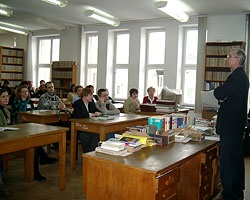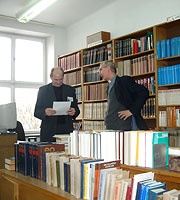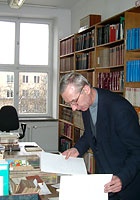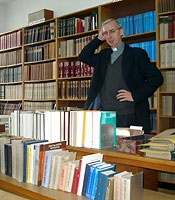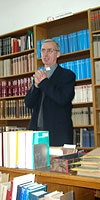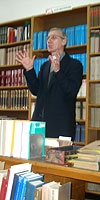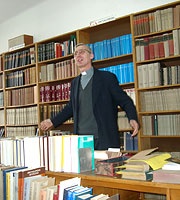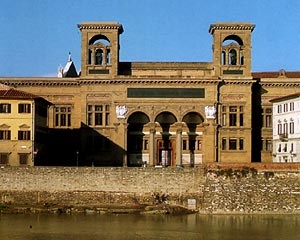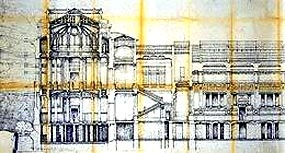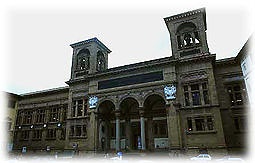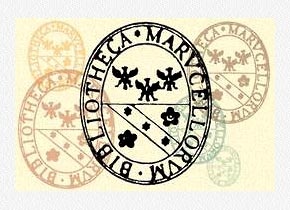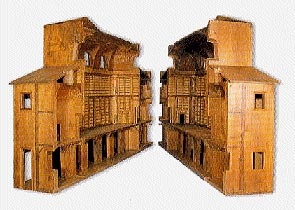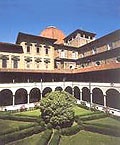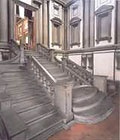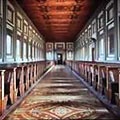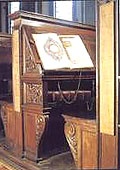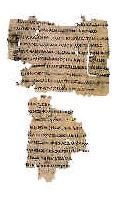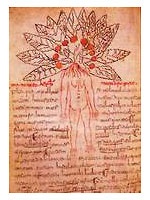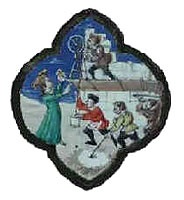Biblioteki Florencji - impresje nie tylko biblioteczne
Ks. dr Tadeusz Stolz
7 kwietnia 2003 r.
|
|
|
|
|
|
|
|
|
| Ksiądz Dyrektor - z iście włoskim temperamentem - barwnie opowiadał o florenckich bibliotekach... Placówki, które przedstawił, to Biblioteca Nazionale Centrale di Firenze, Biblioteca Marucelliana, Biblioteca Medicea Laurenziana i Biblioteca Universitaria (trzy pierwsze kolejno przedstawiamy niżej). |

|
|
Biblioteca Nazionale Centrale Firenze |
internet: www.bncf.firenze.sbn.it
e-mail: info@bncf.firenze.sbn.it
Biblioteka została założona we Florencji w r. 1747. Obecny budynek Centralnej Biblioteki Narodowej zaczął powstawać w roku 1911 na miejscu dawnych koszar; do dziś zachowały się oryginalne plany Cesare Bazzaniego. Budowa trwała do roku 1935.
Wielka powódź w roku 1966 wyrządziła obiektowi wielkie szkody, zagrażając także zbiorom placówki. Do Florencji zjechała wtedy młodzież z Włoch i innych krajów - dzięki przeprowadzonej z jej udziałem ofiarnej akcji ratunkowej ocalono wiele z bezcennych tomów, przechowywanych w BNCF.
Na przełomie wieków XX i XXI zbiory Biblioteki liczyły około 5,5 miliona jednostek (książek i broszur), 25 tysięcy rękopisów, 4 tysiące inkunabułów, 30 tysięcy druków z XVI wieku, ponad milion (!) listów i dokumentów rękopiśmiennych oraz 15 tysięcy map geograficznych. Różnych materiałów graficznych zgromadzono ok. 34 tysiące jednostek. W zbiorach czasopism znajdowało się 115 tysięcy tytułów. Osobnymi działami są zbiory mikrofilmów (ponad 6,5 tysiąca) i materiałów multimedialnych (ponad 1,15 miliona jednostek). Biblioteka zgromadziła też około 26 tysięcy dysertacji doktorskich.
W BNCF pracuje 260 osób, które rocznie obsługują blisko 300 tysięcy czytelników; przez czytelnie przechodzi w ciągu roku ponad dwa razy tyle jednostek bibliotecznych. Liczba wypożyczeń przekracza 18 tysięcy rocznie, do czego dochodzi jeszcze około 1.200 wypożyczeń międzybibliotecznych.
| The BNCF features the Galileo Project, which includes documents and manuscripts related to the scientist's career and to his private life. During 1998 the GALILEO project reached its conclusion: the Galileo collection of BNCF (one of the most important documentary funds for the history of science with 347 handwritten files) has been transferred into a bibliographical and image data base, which includes the transcriptions of the manuscripts and a thesaurus, now available on the Internet site of BNCF. |
|
| The CD ROM - GALILEO DIGITALE - produced as a result of this project won the Pirelli award. |

|
|
|
| internet: http://www.maru.firenze.sbn.it | e-mail: marucelliana@unifi.it |
| Nata nell'ambiente erudito del Sei - Settecento, di cui ne rispecchia gli interessi scientifici e letterari, la Biblioteca fu costituita da Francesco Marucelli, che ne dispose alla sua morte la trasformazione in biblioteca pubblica. Il 18 settembre 1752 la Biblioteca fu aperta al pubblico. Accresciuta delle donazioni degli eredi Marucelli, e da acquisti che ne caratterizzarono la funzione di biblioteca generale ad utilita del vasto pubblico da un lato, e dall'altro di istituzione specializzata in erudizione toscana, alla fine del Settecento la Biblioteca passo sotto il patronato del granduca Pietro Leopoldo. Risale a questi anni la costituzione della sezione di arte industriale, in cui sono raccolte opere di storia delle arti pure e applicate, e della sezione stampe, che costituisce la maggiore ricchezza della Biblioteca con 30.000 incisioni e circa 3200 disegni originali: fanno parte della raccolta esemplari dei maggiori maestri italiani e stranieri del XV e XVII secolo, da Mantegna a Rembrandt. L'attuale patrimonio della Marucelliana, che dal 1911 e depositaria del diritto di stampa per la provincia di Firenze, e di oltre 500.000 opere a stampa; piu di 2000 manoscritti e una raccolta di autografi, fra cui le carte di Francesco Redi, G. Cestoni e alcune lettere di Antonio Vallisneri. |
Biblioteca Medicea Laurenziana
internet: http://www.bml.firenze.sbn.it
e-mail: medicea@unifi.it
The importance of the Biblioteca Medicea Laurenziana, with its collection of nearly 11.000 manuscripts, is based mainly on two converging factors, both extraordinary: the specific nature of the Library’s holdings and the character of its building, which was planned and partly realized by Michelangelo Buonarroti. The story of this Library, from its core collection – the Medici's private library – to the various accessions which followed, has in fact been influenced by a constant aim, viz. the possession of books of a highly textual or esthetical quality.
Amongst the treasures of the Laurenziana are listed some of the most ancient or unique manuscripts containing Tacitus, Pliny, Aeschylus, Sophocles and Quintilian, the codex of Vergil, corrected in 494 by Turcius Rufius Apronianus Asterius, and the oldest extant copy of Justinian's Corpus Iuris, copied just after its promulgation. The Laurenziana also preserves one of the three complete collections of Plato's Dialogi in so-called "carta bona", given by Lorenzo il Magnifico to Marsilio Ficino to translate, the Squarcialupi codex, the only existing source for the study of profane music between the thirteenth and fourteenth centuries, some autographs of Petrarch and Boccaccio, the Storie by Guicciardini with notes by the author as well as the autograph biography of Benvenuto Cellini.
In particular, the Library bears witness to some of the most significant stages of Florentine Renaissance. Coluccio Salutati, Poggio Bracciolini, Niccolo Niccoli, Marsilio Ficino and Pico della Mirandola are all present in the collections not only as authors but as copyists and owners of manuscripts as well. The codices in the Laurenziana also offer many splendid examples of Humanistic reformed script and of the art of the Florentine schools of illumination inspired by Cimabue, Botticelli, the Pollaiolo and Ghirlandaio. Thus, the pursuance of excellence has inspired the growth of the Laurenziana ever since its beginning: from Cosimo de'Medici, tireless founder of libraries, to his descendants, Lords of Florence and Popes of the Holy Roman Catholic Church; from the Medici Grand Dukes to those from Lorraine, who followed their example with intelligence and liberality, up until the enlightened ministers of the newly formed Italian State. As can be expected, such growth was ensured through expropriations, donations and accessions.
Siedziba Biblioteki
Zadanie zaprojektowania i wybudowania odpowiedniej siedziby dla Biblioteki otrzymał Michelangelo Buonarroti (1475 - 1564). Prace zaczęły się w roku 1524 i trwały dziesięć lat, do roku 1534. (...) The splendid stained-glass windows, which were the last part of the Library to be accomplished, display an ornamental array of Medici heraldry referring to Clement VII (1478 - 1534) and Cosimo I (1519 - 1574). Possibly realised by a Flemish workshop in keeping with Giorgio Vasari's drawings, the refined decorations combine grotesque motifs, arms and emblems.
|
Widok ogólny Biblioteki |
Westybul Biblioteki |
Medicea Laurenziana |
Medicea Laurenziana |
Dwie kluczowe daty determinują historię biblioteki:
1571: the origins of the Medici public Library
In 1571, by wish of the Great Duke Cosimo I, the Library was opened to the public in the setting planned by Michelangelo, although the building was still incomplete. The two attributes that have qualified the Library ever since – Medicea and Laurenziana – bear witness to its noble origins as well as to its location in the S. Lorenzo complex. The manuscripts that once belonged to the Medici private library were stripped of their original covers, rebound in red leather with the Medici arms and arranged on benches. The chains still visible on the lower covers of many of these manuscripts bear testimony to the reading practices of the time and the librarians' concern for the safeguard of the collection.
1757: Angelo Maria Bandini and the expropriations during the XVIII and XIX centuries
In 1757 Angelo Maria Bandini was appointed Librarian of the Laurenziana: during nearly fifty years of office he managed an extremely shrewd acquisition policy and published a series of monumental catalogues of the collections, still unrivalled. No great changes occurred in the Library's organization in the two centuries that followed Bandini's death in 1803. The manuscripts coming from libraries once belonging to private families or religious houses suppressed by wish of the Great Duke Pietro Leopoldo or Napoleon were distributed amongst the Florentine libraries according to the usual criterion: the Laurenziana received the Greek and Latin classics, the illuminated specimina as well as an extremely interesting group of Oriental codices. Finally, in 1783, some of the most precious exemplars of the Medici library kept at Palazzo Pitti and passed on to the Biblioteca Palatina Lorenese entered the Laurenziana.
Donations and accessions in the XIX and XX centuries
In 1818 the Florentine bibliophile Angelo Maria d'Elci donated his precious collection of Greek and Latin classics to the Library, all first editions which he had recently rebound, and at the end of the nineteenth century (1884) the Laurenziana acquired the library belonging to Lord Bertram Ashburnham. The latter comprises many splendid items such as the treatise Architettura civile e militare by Francesco di Giorgio Martini, the manuscript of Petrarch's Rime with the arms of Galeazzo Maria Sforza and also a precious little Book of Hours, probably owned by a member of Lorenzo il Magnifico's family.
| Od lewej: - "Papirusy"; - "O lekach i leczeniu", podręcznik medyczno- farmaceutyczny z IX w., Pl. 73.41, f. 93v. - "Rombo", z brewiarza Lorenzo il Magnifico, ok. r. 1470, Plut. 17.28, f. 271v |
|
|
|
The papyri collection, which counts around 2,500 items, is certainly an unusual sight amongst Italian and foreign libraries alike. It's origin can be ascribed to the various campaigns which Italian papyrologists organized in Egypt at the beginning of the twentieth century. Owing to their discoveries, the Laurenziana boasts unique witnesses of the literary production of the ancient world such as verses by Sappho and Callimachus. Having survived the risks of WW2 by storing the manuscripts in the Abbey of Passignano and the benches (the so-called plutei) in the vaults of S. Lorenzo, the Biblioteca Medicea Laurenziana is still, today, an inexhaustible source for classical and humanistic scholars. Finally, the Library's accessions policy involves the buying of significant exemplars – papyri, tablets, codices, rare prints and documents – from international antique dealers. The manuscripts and documents thus acquired augment the "Acquisti e doni" holding, the only one which is still open and comprises, at the moment, around 900 items.
Ostatnia aktualizacja: 14.05.2008, godz. 20:31 - Jan Wasilewski


